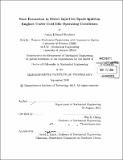Soot formation in direct injection spark ignition engines under cold-idle operating conditions
Author(s)
Ketterer, Justin Edward
DownloadFull printable version (22.62Mb)
Other Contributors
Massachusetts Institute of Technology. Department of Mechanical Engineering.
Advisor
Wai K. Cheng.
Terms of use
Metadata
Show full item recordAbstract
Direct injection spark ignition engines are growing rapidly in popularity, largely due to the fuel efficiency improvements in the turbo-downsized engine configuration that are enabled by direct injection technology. Unfortunately, direct injection spark ignition engines also emit higher concentrations of particulate matter than conventional port fuel injected engines. In light of evidence linking particulate matter to adverse human health impacts, particulate emissions standards have been strengthened in both the United States and in Europe. A great deal of research seeking particulate emissions reductions is ongoing. This study contributes to this body of research by offering a refined explanation of the soot formation process in direct injection engines under cold-idle operating conditions. A number of engine and rapid compression machine experiments were conducted in order to understand the impacts of engine operating conditions and fuel composition on particulate matter emissions. Using these data, a conceptual model describing the formation of soot in direct injection engines is outlined. This model suggests that soot forms after the main combustion event in fuel vapour plumes surrounding liquid fuel films on cylinder surfaces through pyrolytic reactions enabled by heat transfer from burned gases from the primary combustion event.
Description
Thesis: Ph. D., Massachusetts Institute of Technology, Department of Mechanical Engineering, 2013. Cataloged from PDF version of thesis. Includes bibliographical references (pages 167-175).
Date issued
2013Department
Massachusetts Institute of Technology. Department of Mechanical EngineeringPublisher
Massachusetts Institute of Technology
Keywords
Mechanical Engineering.